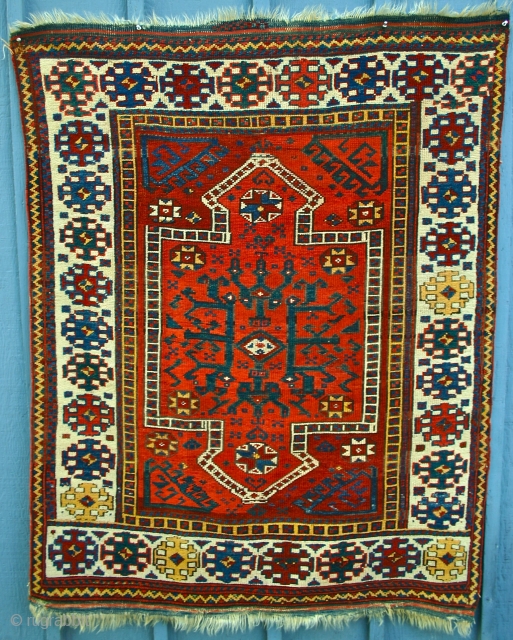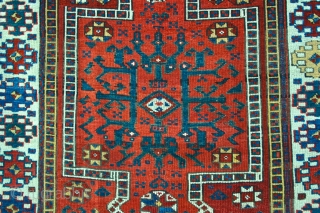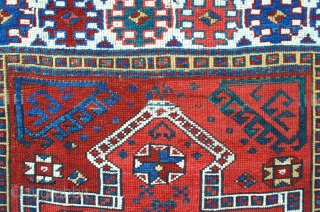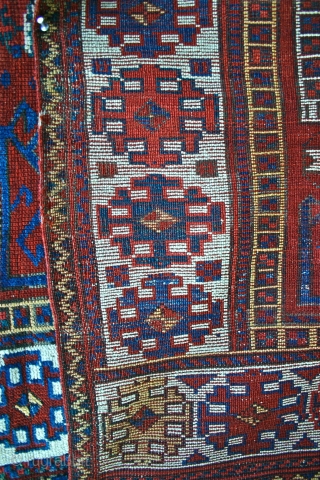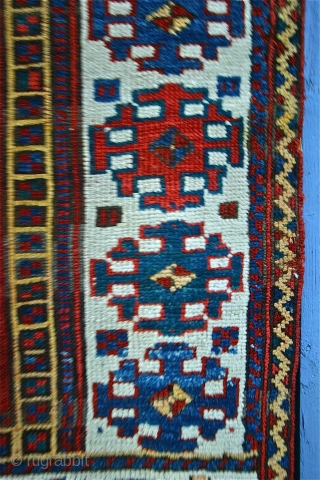Back
Antique Bergama Double Keyhole Village Rug. First Half 19th c. . Size; 5'2" x 4' "This is an interesting antique Bergama with dbl keyhole pattern. i have been contemplating the connection, (if there is one); between the geometric border and the arabesque in the center of the rug.. The rug is old enough, so it is likely that there must be one. If you enlarge the border and place it on top of the central arabesque-medallion, you might see that it is a simplified version of the same design concept; perhaps an eight pointed star in both cases? One needs to consider that these Turkish village adaptions of what were earlier classical designs are not degenerate. They are in fact evolutionary; much in the same way modernism was built on the foundations of classical art and then in th beginning of the 20th century became much more abstract and intuitive. Turkish village rugs from the end of the 18th, into the middle of the 19th c., express this same design progression.... You could call them “Modernist”. After looking thru all 5 volumes from the Turkish Ministry of Culture editions it seems to me that this central design has evolved from a Holbein with the star in the center being retained as the overall conception. It also seems to have a relationship to the leshgi star, as it too seems to have devolved from the Holbein? There is a totemic aspect to the design and there are numerous animals and anthropomorphic definitions observed in the red field. i have checked the few related rugs that i know of and quite a few have this dominant white border. By the way, a further unique feature of this rug is the use of two completely different shades of red, (darker and lighter), in the opposing corners of the field. This is original and not a later restoration; and i have not seen it before.
price:
SOLD!
- Home
- Antique Rugs by Region
- Category
- Profiles
- Post Items Free
- Albums
- Benaki Museum of Islamic Art
- Budapest: Ottoman Carpets
- Gulbenkian Museum
- Islamic Carpets. Brooklyn
- Islamic Textiles. Brooklyn
- Konya Museum: Rugs
- MKG, Hamburg
- MMA: Caucasian Carpets
- MMA: Mamluk Carpets
- MMA: Mughal Indian Carpets
- MMA: Ottoman Carpets
- MMA: Safavid Persian Carpets
- MMA: Turkmen Rugs
- McCoy Jones Kilims
- Ottoman textiles. Met
- Philadelphia Museum
- Rugs and Carpets: Berlin
- Seljuqs at the Met
- TIEM, Istanbul: Carpets
- V&A: Classical Carpets
- Vakiflar Carpets: Istanbul
- Baluch Rugs: Indianapolis
- Gallery Exhibitions
- Jaf an Exhibition
- Alberto Levi Gallery
- Andean Textile
- Christie's London: 2016
- Francesca Galloway
- HALI at 40
- ICOC Washington, DC 2018
- Jajims of the Shahsavan
- London Islamic Week April, 2018
- Mongolian Felts
- Navajo Rugs: JB Moore
- Persian Piled Weavings
- SF Tribal & Textile Art Show 2020
- SF Tribal 2019
- Sotheby's: C. Alexander
- Turkish Prayer Rugs
- Turkmen Main Carpets ICOC 2007







